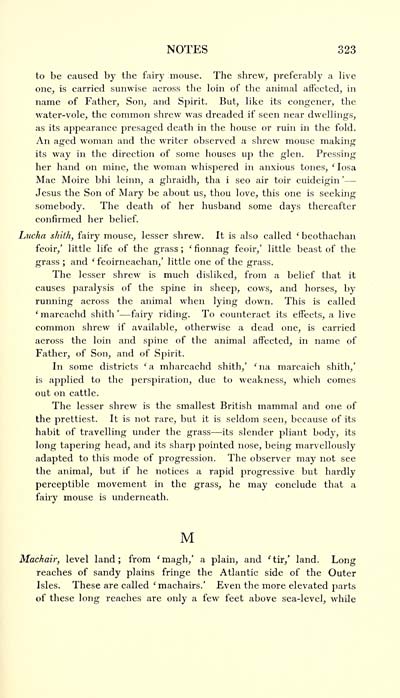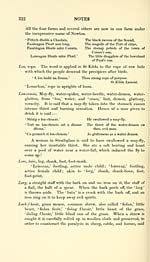Blair Collection > Carmina gadelica > Volume 2
(343)
Download files
Complete book:
Individual page:
Thumbnail gallery: Grid view | List view

NOTES 323
to be caused by the fairy mouse. The shrew, preferably a live
one, is carried sunwise across the loin of the animal affected, in
name of Father, Son, and Spirit. But, like its congener, the
water-vole, the common shrew was dreaded if seen near dwellings,
as its appearance presaged death in the house or ruin in the fold.
An aged woman and the writer observed a shrew mouse making
its way in the direction of some houses up the glen. Pressing
her hand on mine, the woman whispered in anxious tones, ' losa
Mac Moire bin leinn, a ghraidh, tha i seo air toir cuideigin ' —
Jesus the Son of Mary be about us, thou love, this one is seeking
somebody. The death of her husband some days thereafter
confirmed her belief.
Lucha shith, fairy mouse, lesser shrew. It is also called ' beothachan
feoir,' little life of the grass ; ' fionnag feoir,' little beast of the
grass ; and ' feoirneachan,' little one of the grass.
The lesser shrew is much disliked, from a belief that it
causes paralysis of the spine in sheep, cows, and horses, by
running across the animal when lying down. This is called
' marcachd shith ' — fairy riding. To counteract its effects, a live
common shrew if available, otherwise a dead one, is carried
across the loin and spine of the animal affected, in name of
Father, of Son, and of Spirit.
In some districts 'a mharcachd shith,' 'na marcaich shith,'
is applied to the perspiration, due to weakness, which comes
out on cattle.
The lesser shrew is the smallest British mammal and one of
the prettiest. It is not rare, but it is seldom seen, because of its
habit of travelling under the grass — its slender pliant body, its
long tapering head, and its sharp pointed nose, being marvellously
adapted to this mode of progression. The observer may not see
the animal, but if he notices a rapid progressive but hardly
perceptible movement in the grass, he may conclude that a
fairy mouse is underneath.
M
Machair, level land; from 'magh,' a plain, and 'tir,' land. Long
reaches of sandy plains fringe the Atlantic side of the Outer
Isles. These are called 'machairs.' Even the more elevated parts
of these long reaches are only a few feet above sea-level, while
to be caused by the fairy mouse. The shrew, preferably a live
one, is carried sunwise across the loin of the animal affected, in
name of Father, Son, and Spirit. But, like its congener, the
water-vole, the common shrew was dreaded if seen near dwellings,
as its appearance presaged death in the house or ruin in the fold.
An aged woman and the writer observed a shrew mouse making
its way in the direction of some houses up the glen. Pressing
her hand on mine, the woman whispered in anxious tones, ' losa
Mac Moire bin leinn, a ghraidh, tha i seo air toir cuideigin ' —
Jesus the Son of Mary be about us, thou love, this one is seeking
somebody. The death of her husband some days thereafter
confirmed her belief.
Lucha shith, fairy mouse, lesser shrew. It is also called ' beothachan
feoir,' little life of the grass ; ' fionnag feoir,' little beast of the
grass ; and ' feoirneachan,' little one of the grass.
The lesser shrew is much disliked, from a belief that it
causes paralysis of the spine in sheep, cows, and horses, by
running across the animal when lying down. This is called
' marcachd shith ' — fairy riding. To counteract its effects, a live
common shrew if available, otherwise a dead one, is carried
across the loin and spine of the animal affected, in name of
Father, of Son, and of Spirit.
In some districts 'a mharcachd shith,' 'na marcaich shith,'
is applied to the perspiration, due to weakness, which comes
out on cattle.
The lesser shrew is the smallest British mammal and one of
the prettiest. It is not rare, but it is seldom seen, because of its
habit of travelling under the grass — its slender pliant body, its
long tapering head, and its sharp pointed nose, being marvellously
adapted to this mode of progression. The observer may not see
the animal, but if he notices a rapid progressive but hardly
perceptible movement in the grass, he may conclude that a
fairy mouse is underneath.
M
Machair, level land; from 'magh,' a plain, and 'tir,' land. Long
reaches of sandy plains fringe the Atlantic side of the Outer
Isles. These are called 'machairs.' Even the more elevated parts
of these long reaches are only a few feet above sea-level, while
Set display mode to: Large image | Transcription
Images and transcriptions on this page, including medium image downloads, may be used under the Creative Commons Attribution 4.0 International Licence unless otherwise stated. ![]()
| Early Gaelic Book Collections > Blair Collection > Carmina gadelica > Volume 2 > (343) |
|---|
| Permanent URL | https://digital.nls.uk/75758621 |
|---|
| Shelfmark | Blair.70 |
|---|---|
| Attribution and copyright: |
|
| Description | A selection of books from a collection of more than 500 titles, mostly on religious and literary topics. Also includes some material dealing with other Celtic languages and societies. Collection created towards the end of the 19th century by Lady Evelyn Stewart Murray. |
|---|
| Description | Selected items from five 'Special and Named Printed Collections'. Includes books in Gaelic and other Celtic languages, works about the Gaels, their languages, literature, culture and history. |
|---|

